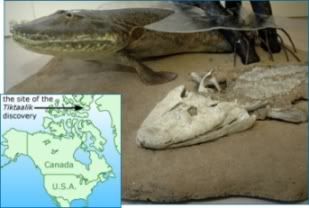"Embrace Your Inner Fish"
Image from: Understanding Evolution - A reconstruction of Tiktaalik alongside a cast of its fossil, and a map showing where the fossil was found, on Ellesmere Island, Nunavut, Canada.
Tiktaalik, of course. Pronounced tik-TAA-lik, this 375 million year old fossil splashed across headlines as soon as its discovery was announced in April of 2006. Unearthed in Arctic Canada by a team of researchers led by Neil Shubin, Edward Daeschler, and Farish Jenkins, Tiktaalik is technically a fish, complete with scales and gills — but it has the flattened head of a crocodile and unusual fins. Its fins have thin ray bones for paddling like most fishes', but they also have sturdy interior bones that would have allowed Tiktaalik to prop itself up in shallow water and use its limbs for support as most four-legged animals do. Those fins and a suite of other characteristics set Tiktaalik apart as something special; it has a combination of features that show the evolutionary transition between swimming fish and their descendents, the four-legged vertebrates — a clade which includes amphibians, dinosaurs, birds, mammals, and of course, humans.
Read more here.
LINKS:
- Tiktaalik roseae
- New Fossils Fill the Evolutionary Gap Between Fish and Land Animals
- Getting a Leg Up on Land
- Tiktaalik makes another gap
- AiG tries to respond to Tiktaalik
- Embrace Your Inner Fish
University of Chicago fossil preparator, Tyler Keillor, discusses the iterative process of creating the model for Tiktaalik, the fossil discovery by paleontologist Neil Shubin that fills in the evolutionary gap between fish and land animals.
Tiktaalik , evolution , transition , transitional fossil , fossils , Paleontology , natural selection , youtube
“You ever noticed how people who believe in Creationism look really unevolved? You ever noticed that? Eyes real close together, eyebrow ridges, big furry hands and feet. "I believe God created me in one day" Yeah, looks like He rushed it.” - Bill Hicks




















17 Comments:
Do you think it will matter that you posted some actual evidence Beep?
Up to the weird fins, it looks a bit like a flat head too. Yummo...:)
Predator instincts come out. (Yum yum flathead!!)
Looks like it could put up a good fight.
It'd have an unfair advantage with those fins too. It could dig right in...
Yes, fish evolving into different fish is proof of evolution.
Transitional speciation: evolution from water to land - it can't get any better.
Except for human chromosome 2 being the result of the fusion of 2 primate chromosomes. That one is pretty special.
Human Chromosome 2 is a fusion of two ancestral chromosomes
http://www.evolutionpages.com/chromosome_2.htm
Amphibian:
"Any of a class of vertebrates that regulate their body temperature externally; lay shell-less eggs in wet areas; live in water during early development and live both in water and on land as adults; and use lungs, gills and their skin for breathing."
well, what do you know. Some didin't quite make it!!!
Here is a better piece of evidance for you, and its not 375 million years old.
http://en.wikipedia.org/wiki/Flying_fish
And the point is?
Animals can evolve within their kind, it is an accepted fact. So how does one fish evolving into another fish give evidance of evolution?
I find the lack of true transitional fossils interesting. That is, a fossil that one would have trouble deciding what kind of animal it is.
Ever wonder why they were named "missing links"?
"Missing link" is an inappropriate term when referring to a transitional form not yet discovered in the fossil record.
"Missing" usually describes something that was supposed to be present but has disappeared for unknown reasons — if, for example, a favorite book suddenly disappeared from your room But you wouldn't describe the book as "missing" if you had lent it to a friend and expected it to be gone.
The same arguments apply to so-called "missing links." Biologists know that fossilization is a chancy process — most things that have lived on Earth are eaten or rot away before they can be fossilized.
Very few organisms wind up in situations in which fossilization is possible and have body parts that can be preserved in fossils.
Thus, biologists expect that most intervening steps of an evolutionary transition (such as vertebrates' invasion of the land) will not be preserved in the fossil record.
Occasionally, we get lucky and discover a transitional form that has been preserved in a fossil — but that does not imply that its ancestors, descendents, or other organisms that once lived on Earth are "missing."
http://evolution.berkeley.edu/evolibrary/news/060501_tiktaalik
Yet another fossil planted in the ground by Satan to fool gullible minds!
;-)
""Missing link" is an inappropriate term"
Wonder why they were named that.
"Very few organisms wind up in situations in which fossilization is possible and have body parts that can be preserved in fossils."
Very few in relation to the total, not just as a number. There are plenty of fossils that have been found, I have collected quite a few myself. The point is that there are no fossils that one would be hard pressed to say wheather it was say a dinasour or a bird, for example.
"Missing link" is usually a term used not by scientists, but by the media to grab headlines. It is also used by creationists and literalists as it depicts an inaccurate representation of a scientific concept.
Yes, missing links are now called "Transitional fossils"; spontaneous generation is now called "Abiogenesis"
The names for these things were changed so scientists would not sound like idiots saying "I believe in spontaneous generation, we evolved from single cell organisms, missing links prove it."
A popular term to designate transitional forms with is "the missing link". The term is especially used in the regular media, but inaccurate and confusing.
This is partly because it implies that there was a single link missing to complete the picture, which now has been discovered.
In reality, the continuing discovery of more and more transitional fossils is further adding to our knowledge of evolutionary transitions.
The term probably arose in the 19th century where the awaited discovery of a "missing link" between humans and so-called "lower" animals was considered to be the final proof of evolution.
It isn't an apt description because it suggests that fossils follow a completely linear progression like the links in a single chain. They don't.
A simple graphic model for evolution would be better represented like a tree with many branches. Twigs joined to smal branches, small branches joined to bigger branches and bigger branches joined to a trunk, or even a mutiple trunk.
This is why the idea of a "missing link" is replaced by the more apt description term of a transitional fossil. A transitional fossil is representative of a past organism which shows physical or biological characteristics of other known organisms and can be said to be ralted to them because of these characteristics.
The term "missing link" implies that there would only be one evolutionary link from sea animals to land animals. The number of fossils found does not indicate this.
Example: Fish to Amphibians and some transitional fossils - (Tiktaalik roseae, Osteolepis, Eusthenopteron,
Panderichthys, Elginerpeton, Obruchevichthys, Hynerpeton, Tulerpeton, Acanthostega, Ichthyostega, Pederpes finneyae and
Eryops)
or, you could just add an "s".
Or, you could just read a science book.
Post a Comment
<< Home